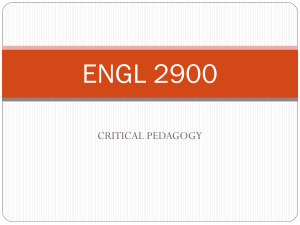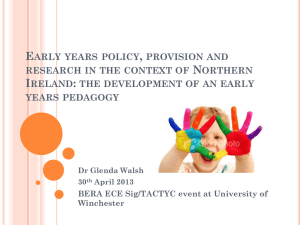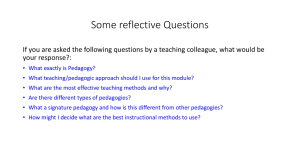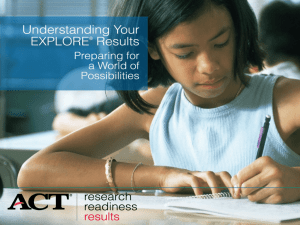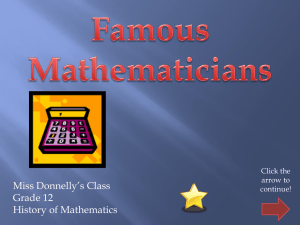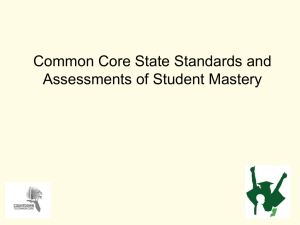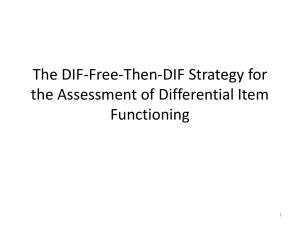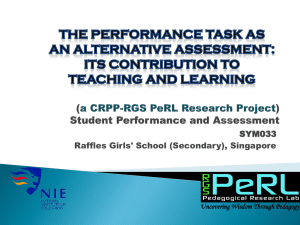Measuring Pedagogies from Secondary School to
advertisement
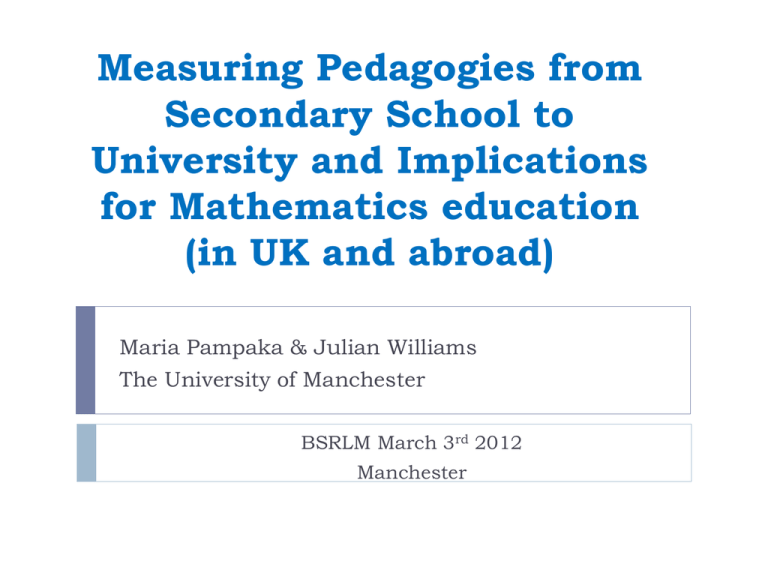
Measuring Pedagogies from Secondary School to University and Implications for Mathematics education (in UK and abroad) Maria Pampaka & Julian Williams The University of Manchester BSRLM March 3rd 2012 Manchester Outline Introduction: STEM, reform and pedagogy Background to the projects (college) Teachers’ reported pedagogical practices (and effect on models of students’ dispositions) Students’ reported perception of pre-university pedagogical experience Comparison of measures from UK and Norway Some more comparisons and associations (Pedagogy at Secondary school) Concluding remarks Introduction: The STEM ‘issue’ STEM: Science Technology, Engineering and Mathematics Participation remains problematic Students dispositions are declining Introduction: Reform and pedagogy Worldwide ‘reform agenda’ of mathematics teaching: emphasis on problem-solving, creativity, and discussion to improve both understanding and dispositions towards the subject (NCTM, 2000). BUT, many studies (e.g. TIMSS), have shown how attitudes to mathematics and science are in decline, and that some part of this decline is associated with efforts aimed at increasing standards Focus on standards is closely associated with traditional teaching, and the marginalisation of reform approaches the drive to raise standards can be counterproductive for dispositions, especially when it has the effect of narrowing teaching practices. gap in evidence Towards a conceptual framework for pedagogic practice Research on learning environments Classroom Practices: teacher centred Vs Widely accepted that effective connectionist, in two ways: learner-centred maths teaching should be connecting teaching to students’ mathematical understandings, and productions connecting teaching and learning across mathematics’ topics, and between mathematics and other (e.g., scientific) knowledge. Missing from the debate: informed analysis of teachers’ pedagogy at this level and the impact that this has on student outcomes in terms not only of attainment in, but also developing dispositions towards, mathematics and mathematically demanding subjects. We try to address this under-researched association Our focus Development of the measure of teacher self-reported pre-university pedagogy and its association with students’ learning outcomes The ‘conversion’ of this pedagogy instrument into two measures of students’ perceived pedagogical experience before and during their first year at university in UK and in Norway (cross-national comparisons) [The extension/development of these instruments backwards to capture secondary students’ progression into secondary schools (Year 7 to 11)] The Projects ESRC funded projects on transition to mathematically demanding subjects in UK Higher Education (HE): TransMaths TLRP: “Keeping open the door to mathematically demanding F&HE programmes” (2006 – 2008) TransMaths: “Mathematics learning, identity and educational practice: the transition into Higher Education” (2008-2010) An extension of this work in Norway: TransMaths-Norway Lead PI: Prof Julian Williams Lead PI: Prof Birgit Pepin Ongoing ESRC funded study of teaching and learning secondary mathematics in UK (2011-2014): Teleprism PI: Dr Maria Pampaka The TransMaths Project(s) Design TLRP project TIME Cohort’s Educational Level Data Point TransMaths project Sept-Nov 2006 April-June 2007 Sept-Dec 2007 July-Sept 2008 Feb-May 2008 Oct 2009 – Jan 2010 Start of AS End of AS Start of A2 End of A2 Pre-HE Mid First Year HE Start of Second year HE DP1 DP2 DP3 DP1 [DP4] DP2 [DP5] DP3 [DP6] TransMaths-Norway: University Transition in Norway TeLePriSM: Dispositions and Pedagogies at Secondary Mathematics UK (Year 7 to 11) Analytical Framework Instrument Development Measures’ Construction and Validation (Rasch Model) Model Building (Multiple Regression, GLM) Instrumentation TLRP project TIME Cohort’s Educational Level Data Point TransMaths project Sept-Nov 2006 April-June 2007 Sept-Dec 2007 July-Sept 2008 Feb-May 2008 Oct 2009 – Jan 2010 Start of AS End of AS Start of A2 End of A2 Pre-HE Mid First Year HE Start of Second year HE DP1 DP2 DP3 DP1 [DP4] DP2 [DP5] DP3 [DP6] Teachers’ Survey Students’ perception of preuniversity pedagogy Students’ perception of university pedagogy Teleprism: • Measures of teachers’ self report teaching • Students’ perception of teaching • Common items Norway Teacher Instrument Development 28 items 5 point Likert Scale (for frequency) Calibrated Swan’s original data Re-calibration with 110 cases from TLRP project Analytical Framework Instrument Development Measures’ Construction and Validation (Rasch Model) Model Building (Multiple Regression, GLM) Measurement Methodology ‘Theoretically’: Rasch Analysis Partial Credit Model Rating Scale Model (for the pedagogic measure) ‘In practice’ – the tools: FACETS, Quest and Winsteps software Interpreting Results: Fit Statistics (to ensure unidimensional measures) Differential Item Functioning for ‘subject’ groups Person-Item maps for hierarchy A measure of “pedagogical style”: “Teacher centricism” Scale Validation supported with Qualitative Data “… there’s a sense that I’ve achieved the purpose…I’ve found out what they’ve come with and what they haven’t come with so…we can work with that now” “…. from the teachers that I’ve met and talked to… it seems to me that one of the big differences is, I mean I don’t sort of use textbooks… [ ]…I want to get students to think about the math, I want students to understand, I want students to connect ideas together, to see all those things that go together and I don’t think a text book did that….” Here we work backwards, here the student has got a certain data and then trying to find a model for that so directly comes to their need. So they measure something, they take some reading and now they want to put a mathematical language to this finding and I always find a model for that language. Sally Tania [-1.62] [-1.17] Level 1: Extreme Student-centered Student Centred Connectionist practice Sal [-0.18] Vladimir [0.05] Eddie [0.32] Level 2: “Medium” - Teaching practices from both ends TEACHER CENTRISM SCALE Level 3: Teacher-centred, transmissionist, fast paced, exam orientated Danny [0.74] Green [0.78] Rania [0.87] Extreme Teacher Centred John [2.08] …. I think Powerpoint and text just switches everybody off if there is too much text on there. We don’t want to read off the screen. That is more or less for me to do the explanations as we run through it and then consolidate that with them doing something. “…I do tend to teach to the syllabus now…If it’s not on I don’t teach it. … but I do tend to say this is going to be on the exam, it’s going to be worth X number of marks, that’s why we’re doing it.” “It’s old fashion methods, there’s a bit of input from me at the front and then I try to get them working, practising questions as quickly as possible, …” Using the measures to answer RQ Instrument Development Measures’ Construction and Validation (Rasch Model) Model Building (Multiple Regression, GLM) The TLRP sample From Measurement to Modelling Outcome Measure [A] DP(n) = Outcome Measure [A] DP(n-1) + Related Outcome Measures [B,C,..] + Variables • Outcome of AS Maths (Grade, or Dropout) Background Variables Disposition Measures at each DP • • – – – • Process variables [course, pedagogy,..] + Disposition to go into HE (HEdisp) Disposition to study mathematically demanding subjects in HE (MHEdisp) Maths Self Efficacy A score of ‘pedagogy’ based on teacher’s survey Background variables A model of HE Maths Disposition at the end of AS year Positive effect: Math Disposition at DP1, ‘Mathematical demand of other subjects’ Negative effect: pedagogy -0.5 -0.6 Negative effect of Pedagogy ASTrad UoM Course AveragePed effect plot 0.6 0.4 MHEdisp2 0.2 0 -0.2 -0.4 -0.6 -0.8 -1 -1 0 1 AveragePed 2 Extensions: From TLRP teacher survey to a student instrument Students’ pre-uni pedagogical experience Item Fit Statistics (UK): N=1516 students -------------------------------------------------------------------------------------------------| Obsvd Obsvd Obsvd Fair-M| Model | Infit Outfit | | | | Score Count Average Avrage|Measure S.E. |MnSq ZStd MnSq ZStd | PtBis | Nu Items | -------------------------------------------------------------------------------------------------| 4568 1499 3.0 3.11| -.50 .04 | 0.9 -4 0.9 -3 | .32 | 1 item1 | | 4125 1488 2.8 2.82| -.01 .03 | 0.9 -3 0.9 -3 | .38 | 2 item2 | | 3668 1494 2.5 2.47| .51 .03 | 0.8 -5 0.8 -5 | .45 | 3 item3 | | 3524 1478 2.4 2.39| .63 .03 | 1.0 0 1.0 0 | .38 | 4 item4 | | 4180 1493 2.8 2.85| -.06 .03 | 1.0 0 1.0 0 | .48 | 5 item5 | | 3750 1494 2.5 2.53| .42 .03 | 0.9 -4 0.8 -4 | .55 | 6 item6 | | 4150 1493 2.8 2.82| -.02 .03 | 1.1 1 1.1 2 | .33 | 7 item7 | | 4825 1486 3.2 3.31| -.90 .04 | 1.1 2 1.0 0 | .44 | 8 item8 | | 4195 1489 2.8 2.86| -.09 .03 | 1.0 0 1.0 0 | .35 | 9 item9 | | 3875 1488 2.6 2.63| .27 .03 | 1.4 9 1.5 9 | .07 | 10 item10 | | 4294 1475 2.9 2.96| -.25 .03 | 1.1 3 1.1 3 | .24 | 11 item11 | -------------------------------------------------------------------------------------------------| 4104.9 1488.8 2.8 2.80| .00 .03 | 1.0 -0.3 1.0 -0.3| .36 | Mean (Count: 11) | | 368.3 6.8 0.2 0.26| .43 .00 | 0.2 4.1 0.2 4.0| .12 | S.D. | -------------------------------------------------------------------------------------------------RMSE (Model) .03 Adj S.D. .43 Separation 12.53 Reliability .99 Fixed (all same) chi-square: 1634.3 d.f.: 10 significance: .00 Random (normal) chi-square: 10.0 d.f.: 9 significance: .35 -------------------------------------------------------------------------------------------------- Item 10: The teacher was encouraging us to work more quickly Students’ pre-uni pedagogical experience Item Fit Statistics (Norway): N=709 -------------------------------------------------------------------------------------------------| Obsvd Obsvd Obsvd Fair-M| Model | Infit Outfit | | | | Score Count Average Avrage|Measure S.E. |MnSq ZStd MnSq ZStd | PtBis | Nu Items | -------------------------------------------------------------------------------------------------| 2312 700 3.3 3.37| -.57 .06 | 1.0 0 1.1 1 | .28 | 1 item1 | | 2100 702 3.0 3.05| .07 .05 | 1.0 0 1.0 0 | .35 | 2 item2 | | 2110 695 3.0 3.10| -.02 .05 | 0.7 -5 0.7 -5 | .46 | 3 item3 | | 1954 679 2.9 2.93| .27 .05 | 0.8 -3 0.9 -2 | .38 | 4 item4 | | 2150 703 3.1 3.12| -.06 .05 | 1.1 2 1.1 1 | .40 | 5 item5 | | 2173 702 3.1 3.15| -.12 .05 | 0.9 -1 0.9 -1 | .51 | 6 item6 | | 1768 704 2.5 2.52| .92 .05 | 1.1 2 1.1 2 | .29 | 7 item7 | | 2435 697 3.5 3.56| -1.05 .06 | 1.0 0 0.9 -1 | .42 | 8 item8 | | 2368 705 3.4 3.43| -.70 .06 | 1.0 0 1.0 0 | .33 | 9 item9 | | 1434 676 2.1 2.09| 1.58 .05 | 1.4 7 1.5 8 | .13 | 10 item10 | | 2158 675 3.2 3.26| -.33 .06 | 0.9 -2 0.9 -1 | .33 | 11 item11 | -------------------------------------------------------------------------------------------------| 2087.5 694.4 3.0 3.05| .00 .05 | 1.0 -0.1 1.0 0.0| .35 | Mean (Count: 11) | | 272.0 11.2 0.4 0.40| .70 .00 | 0.2 3.3 0.2 3.5| .10 | S.D. | -------------------------------------------------------------------------------------------------RMSE (Model) .05 Adj S.D. .70 Separation 12.93 Reliability .99 Fixed (all same) chi-square: 1862.4 d.f.: 10 significance: .00 Random (normal) chi-square: 10.0 d.f.: 9 significance: .35 -------------------------------------------------------------------------------------------------- The issue here: Assuming the two projects were independent: we have two valid (separate) measures of students’ perceptions of their pre-university mathematical teaching no problem BUT: if we were to link the data of the two projects and proceed with comparative statements more needs to be done In Rasch (measurement) terms: we need to explore and deal with DIF Differential Item Functioning (DIF) • • • • • When a variable is used with different groups of persons [or to measure the same persons on different occasions], it is essential that the identity of the variable be maintained from group to group. Only if the item calibrations are invariant from group to group can meaningful comparisons of person measures be made. Differential Item Functioning (DIF): a statistical way to inform this process DIF measurement may be used to reduce this source of test invalidity and allows researchers to concentrate on the other explanations for group differences in test scores. Groups here: Students from UK and Norway UK ------------------------------------|Measr|-Items |+persons |S.1 | ------------------------------------+ 4 + + . +(4) + | | | | | | | | . | | | | | | | | | | | | | | | | | | | | | | | | | | | + 3 + + *. + + | | | | | | | | | | | | | . | | | | | | | | | | . | | | | | *. | | | | | . | | + 2 + + *. + + | | | . | | | | | ***. | --- | | | | . | | | | | ****. | | | | | . | | | | | ****. | | | | | *****. | | + 1 + + . + + | | | ****** | | | | | ********. | 3 | | | 4 | *******. | | | | 3 | ********. | | | | 6 | *******. | | | | 10 | . | | | | | *********. | | * 0 * 2 5 7 * *******. * --- * | | 9 | *******. | | | | 11 | *******. | | | | | ******. | | | | 1 | ****. | | | | | **. | | | | | *. | 2 | | | 8 | . | | + -1 + + *. + + | | | *. | | | | | *. | | | | | | | | | | . | | | | | | | | | | . | --- | | | | . | | + -2 + + +(1) + ------------------------------------|Measr|-Items | * = 13 |S.1 | ------------------------------------- Norway --------------------------------|Measr|-Items |+persons |S.1 | --------------------------------+ 5 + + . +(4) + | | | | | | | | | | | | | | | | | | | | | | | | | | | | | | + 4 + + . + + | | | | | | | | | | | | | | | | | | . | | | | | . | | | | | . | | + 3 + + + + | | | . | | | | | **. | | | | | | | | | | **. | | | | | | | | | | ***** | | + 2 + + . + + | | | ******. | --- | | | | | | | | 10 | ******. | | | | | *****. | | | | | . | | | | | ********. | | + 1 + + ********. + + | | 7 | ********* | | | | | *******. | 3 | | | | ******* | | | | | . | | | | 4 | *******. | | | | 2 | ****. | | * 0 * 3 5 * *****. * --- * | | 6 | ****. | | | | 11 | **. | | | | | *. | | | | 1 | *. | | | | 9 | * | | | | | . | 2 | + -1 + 8 + . + + | | | . | | | | | | | | | | | | | | | | | | | | | | | | | . | --- | + -2 + + +(1) + --------------------------------|Measr|-Items | * = 7 |S.1 | --------------------------------- Differential Item Functioning (DIF): Item measures of the two groups PERSON DIF plot (DIF=@COUNTRY) ITEM 2 1.5 DIF Measure (diff.) 1 Norway 0.5 0 -0.5 -1 -1.5 UK Differential Item Functioning (DIF) Harder for Norwegian students to report frequency 1.6 Ped10: Teacher encourage students to work more quickly 1.4 1.2 1.0 Ped7: [not] Work collaboratively in pairs 0.8 0.6 Norway 0.4 Ped4: Teacher [not] draws links between topics 0.2 Ped3: Students [not] compare different methods 0.0 -0.2 Ped6: Students [not] discuss their ideas -0.4 -0.6 Ped9: Teacher tells which questions to tackle Easier -0.8 for Norwegian students to report frequency -1.0 -1.2 -1.1 -0.9 -0.7 -0.5 -0.3 -0.1 0.1 UK 0.3 0.5 0.7 0.9 1.1 Differential Item Functioning DIF refers to a psychometric difference in how an item functions for two groups. DIF refers to a difference in item performance between two comparable groups of examinees, that is, groups that are matched with respect to the construct being measured by the test. The comparison of matched or comparable groups is critical because it is important to distinguish between differences in item functioning from differences between groups” (Dorans & Holland, 1993, p. 35). So the question remains: Is the instrument biased or differences are due to real differences? Plotting students’ measures with two different analysis A comparative question Are the students from these two countries exposed to different pre-university practices? (according to their report) The Norwegian students reported more transmissionist practices in their preuniversity maths courses t=11.66, p<0.001 Another question How is this measure of students’ perceived pre-university pedagogical experience associated with other measures of interest (e.g. dispositions, grades etc) Some correlations from TransMaths UK Pearson Correlations UK results Pedagogy at Uni Pre-University Pedagogy Math Support at University (DP5) Non significant -0.19 (p<0.05) Transitional Feelings (DP5) -0.20 (p<0.001) Non significant Disposition to Finish Course_DP5 -0.12 (p<0.05) Non significant Math confidence (DP5) Non significant -0.17 (p<0.001) MHE disposition (DP5) Non significant -0.19 (p<0.001) Key Never Rarely Sometimes Always Item name The teacher asks us questions. The teacher tells us which questions/activities to do. The teacher asks us to explain how we get our answers. We listen to the teacher talk about the topic. The teacher expects us to remember important ideas learnt in the past. We copy the teacher's notes from the board. The teacher gives us problems to investigate. The teacher asks us what we already know about a lesson topic. We discuss ideas with the whole classroom. The teacher uses the computer to teach some topics. The Teleprism student survey and some initial findings We talk with other students about how to solve problems. We work through exercises from the textbook. We use calculators. We ask other students to explain their ideas. We explain our work to the whole class. The teacher tells us to work more quickly. The teacher tells us what value the lesson topic has for future use. We work together in groups on projects. What we learn is related with our out-of-school life. We learn that mathematics is about inventing rules. We get assignments to research topics on our own. The teacher starts new topics with problems about the world. We use computers. We do projects (assignments) that include other school subjects. We learn how mathematics has changed over time. We use other things like newspapers, magazines, or video. Frequency bars Some concluding points We showed how it is possible to measure ‘pedagogy’ across various stages of mathematics education (from Secondary School to University) Cross-national comparability Still to come: University pedagogy cross national comparisons (Norway UK) Modeling of dispositions considering pedagogy (Norway) Student’s perceptions vs their teachers’ perceptions (Teleprism) How teachers reported pedagogies are shaped? (Teleprism) References – for more information Pampaka, M., Williams, J. & Hutcheson, G. (2011). Measuring students’ transition into University and its association with learning outcomes. British Educational Research Journal. First published on: 14 September 2011 (iFirst). Pampaka, M., Williams, J., Hutcheson, G. D., Wake, G., Black, L., Davis, P., & Hernandez-Martinez, P. (2011). The association between mathematics pedagogy and learners’ dispositions for university study. British Educational Research Journal: First published on: 15 April 2011 (iFirst). Hutcheson, G. D., Pampaka, M., & Williams, J. (2011). Enrolment, achievement and retention on 'traditional' and 'Use of mathematics' pre-university courses. Research in Mathematics Education, 13 (2), 147-168. D Williams, J., Black, L., Hernandez-Martinez, P., Davis, P., Pampaka, M. & Wake, G. (2009). Repertoires of aspiration, narratives of identity, and cultural models of mathematics in practice. In M. César & K. Kumpulainen (Eds), Social Interactions in Multicultural Settings (Chapter 2, pp. 39-69). Rotterdam: Sense. Williams, J., Black, L., Hernandez-Martinez, P., Davis, P. Pampaka, M. & Wake, G. (2009). Pedagogies for social diversity and difference. In M. David et. al. (Eds), Improving learning by Widening Participation in Higher Education (pp. 109 -123). London: Routledge.
